|
|
 |
 |
 |
 |
 |
 |
| |
| |
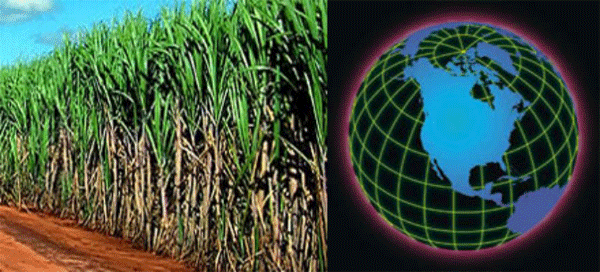 |
Sugarcane is tall perennial grasses (family Poaceae, tribe Andropogoneae),
native to warm temperate to tropical regions of the World. They have stout,
jointed, fibrous stalks that are rich in sugar and measure 2 to 6 meters
tall. All of the sugar cane species interbreed, and the major commercial
cultivars are complex hybrids.
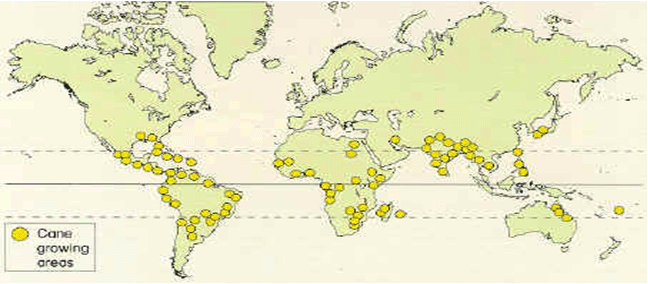
About 195 countries grow the crop to produce 1.5 billion tonnes. The
world's largest producer of sugar cane by far is Brazil followed by India.
Uses of sugar cane include the production of sugar, Falernum, molasses,
rum, soda, cachaça (the national spirit of Brazil) and ethanol
for fuel. The bagasse that remains after sugar cane crushing may be burned
to provide both heat - used in the mill - and electricity, typically sold
to the consumer electricity grid. It may also, because of its high cellulose
content, be used as raw material for paper, cardboard, and eating utensils
branded as "environmentally friendly" as it is made from a by-product
of sugar production.
Sugarcane was originally from tropical South Asia and Southeast Asia.
Different species likely originated in different locations originating
in India and from New Guinea. The thick stalk stores energy as sucrose
in the sap. From this juice, sugar is extracted by evaporating the water.
Crystallized sugar was reported 5000 years ago in India.
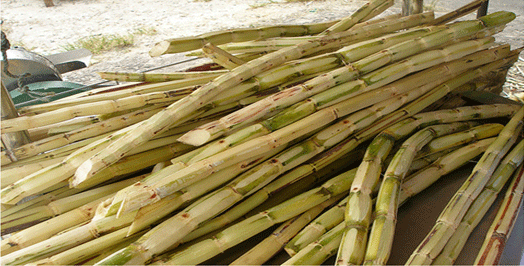
Around the eighth century A.D., Arabs introduced sugar to the Mediterranean,
Mesopotamia, Egypt, North Africa, and Spain. By the tenth century, sources
state, there was no village in Mesopotamia that didn't grow sugar cane.
It was among the early crops brought to the Americas by Spaniards. Brazil
is currently the biggest sugar cane producing country.
A boiling house was used in the 17th through 19th centuries to make
sugarcane juice into raw sugar. These houses were add-ons to the sugar
plantations in the western colonies. This process was often conducted
by the African slaves, under very poor conditions. The boiling house was
made of cut stone. The furnaces were rectangular boxes of brick or stone
with openings near to one side, and at the bottom to stoke the fire and
pull out the ashes. At the top of each furnace were up to seven copper
kettles or boilers, each one smaller than the previous one and hotter.
The cane juice was placed in the first copper kettle which was the largest.
The juice was then heated and a little lime added to remove impurities.
The juice was then skimmed then channeled to the other copper kettles.
The last kettle, which was called the 'teache' was where the cane juice
became syrup. It was then put into cooling troughs where the sugar crystals
hardened around a sticky core of molasses. The raw sugar was then shoveled
from the cooling trough into hogsheads (wooden barrels) where they were
put in the curing house.
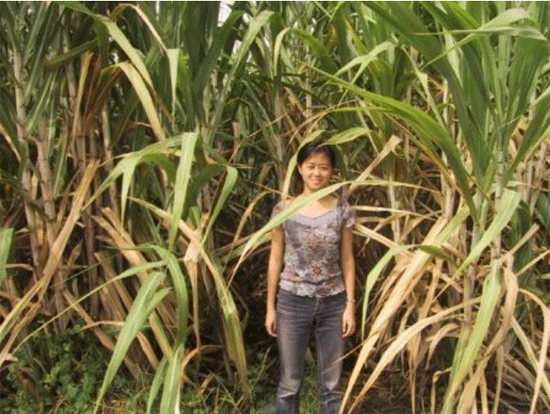
Sugarcane was, and still is, extensively grown in the Caribbean, where
it was first brought by Christopher Columbus during his second voyage
to The Americas, initially to the island of Hispaniola (modern day Haiti
and the Dominican Republic) . In colonial times, sugar was a major product
of the triangular trade of New World raw materials, European manufactures,
and African slaves. France found its sugarcane islands so valuable it
effectively traded its portion of Canada, famously dubbed "a few
acres of snow," to Britain for their return of Guadeloupe, Martinique
and St. Lucia at the end of the Seven Years' War.
The Dutch similarly kept Suriname, a sugar colony in South America,
instead of seeking the return of the New Netherlands (New Amsterdam).
Cuban sugarcane produced sugar that received price supports from and a
guaranteed m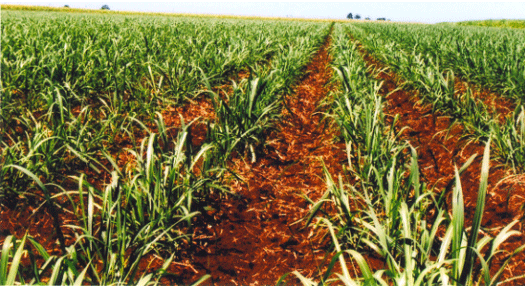 arket in the USSR; the dissolution
of that country forced the closure of most of Cuba's sugar industry. Sugarcane
remains an important part of the economy of Belize, Barbados, Haiti along
with the Dominican Republic, Guadeloupe, Jamaica, and other islands. The
sugarcane industry is a major export for the Caribbean, but it is expected
to collapse with the removal of European preferences by 2009. arket in the USSR; the dissolution
of that country forced the closure of most of Cuba's sugar industry. Sugarcane
remains an important part of the economy of Belize, Barbados, Haiti along
with the Dominican Republic, Guadeloupe, Jamaica, and other islands. The
sugarcane industry is a major export for the Caribbean, but it is expected
to collapse with the removal of European preferences by 2009.
Sugarcane production grown between lattitude 30º North and 30º
South has greatly influenced many tropical Pacific islands, including
Okinawa and most particularly Hawaii and Fiji. In these islands, sugar
cane came to dominate the economic and political landscape after the arrival
of powerful European and American agricultural business, which promoted
immigration from various Asian countries for workers to tend and harvest
the crop. Sugar-industry policies eventually established the ethnic makeup
of the island populations that now exist, profoundly affecting modern
politics and society in the islands.
In the modern times sugar is produced predominately from the sugarcane
in the following countries.
| Argentina |
Mauritius |
Australia |
| Mexico |
Bangladesh |
Mozambique |
| Belize |
Nicaragua |
Brazil |
| Nigeria |
China * |
Pakistan |
| China (Taiwan Prov.) |
Panama |
Colombia |
| Papua New Guinea |
Dominican Republic |
Peru |
| Ecuador |
Philippines |
Egypt * |
| Senegal |
El Salvador |
South Africa |
| Ethiopia |
Sudan |
Fiji |
| Swaziland |
Guatemala |
Tanzania |
| Guyana |
Thailand |
Honduras |
| Trinidad & Tobago |
India |
Uganda |
| Indonesia |
Uruguay |
Jamaica |
| Zambia |
Lao PDR |
Zimbabwe |
| Kenya |
Malaysia |
|
* Countries also growing beet for Sugar.
Source:- International Sugar Organization Oct 2009,
Brazil is a major grower of sugarcane, which is used to produce sugar
and provide the ethanol used in making gasoline-ethanol blends (gasohol)
for transportation fuel. In India, sugarcane is sold as jaggery and also
refined into sugar, primarily for consumption in tea and sweets, and for
the production of alcoholic beverages. |
| |
| Sugarcane Production in Pakistan |
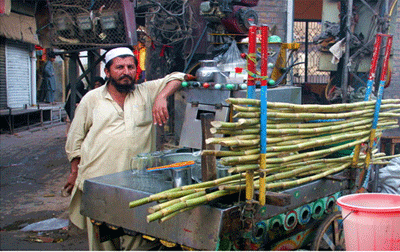 Sugarcane is grown in Pakistan from
the time immemorial attributed to the mighty river Indus and its tributaries.
The region, known as Indus valley civilization historically had the knowledge
of sugarcane production and the extraction of brown sugar cakes, even
now locally known as Gur being produced traded and liked by the people.
Traditionally sugarcane juice and pealed cut in mall pieces for chewing
used round the year. Sugarcane is grown in Pakistan from
the time immemorial attributed to the mighty river Indus and its tributaries.
The region, known as Indus valley civilization historically had the knowledge
of sugarcane production and the extraction of brown sugar cakes, even
now locally known as Gur being produced traded and liked by the people.
Traditionally sugarcane juice and pealed cut in mall pieces for chewing
used round the year.
The areas falling between latitude 24º and 34ºN, which can
be classified as irrigated sub-tropical zones with moderate temperature
are suitable for the cultivation of the sugarcane. The region can be termed
as frost free zone except for the area lying above 30º N which is
occasionally hit by frosts.
Sugarcane occupies nearly 1.0 million hectares of the cultivated land
out of the available 22.0 million hectares i.e. about 4.5% of the irrigated
land. The crop needs about 10 MAF (million acre-feet) of water from the
total availability of about 135 MAF in the present system and reservoirs.
Known as high delta crop it has always been susceptible to the weather
cycle, restricting its expansion outside this ecological zone.
Sugar industry in Pakistan now well developed is operating at around
70% of its capacity. The annual cane production fluctuates between 45
million and 65 million tonnes depending on irrigation water supplies and
rains, whereas the present industrial capacity can mill at least 70 million
tonnes. Good and bad crop years have meant that the growers revenues have
been unstable and uncertain against the specter of ever increasing input
cost. Research and development on the sugarcane crop has not been to the
desired mark and no noticeable variety improvement has been fielded in
the past years. This is one of the main factors affecting the survival
of the sugar industry. The variety development in Pakistan does not match
the expansion in the sugar industry and neither the industry has any systematic
programme for variety propagation.
Over the past six decades productivity increase 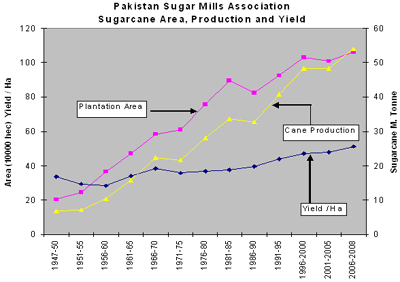 has
been marginal (see Figure below). has
been marginal (see Figure below).
This current low yield of 48 t/ha clearly exposes cane production as
the weak link in the overall value chain. Combination of cane price, rising
input costs and lack of actionable research products from the local and
national research institutes explain why there has not been significant
growth in productivity, and also the challenges facing the industry. The
growers need to have sufficient incentive in terms of the price they receive
for their cane so that they will optimize the use of inputs to produce
quality cane and high yields. The role of the government here is of paramount
importance.
A brief on cane varieties in use in Pakistan is presented here render
for readers short introduction.
For details see “Sugarcane
Varieties Situation in Pakistan” contributed by Karim Bakhsh
Malik a renowned sugar technologist. |
| |
Punjab
Amongst the three cane growing provinces of Pakistan, Punjab is leading
in cane variety evolution programme. Sugar cane Research Institute, Faisalabad
has released a number of varieties since its inception. Shakarganj Research
Institute, Jhang has also an active variety selection programme and has
evolved one variety as SPSG26.
Cane varieties in cultivation are:
CPF 242, HSF 240, SPF 234, CPF 213, CPF 237, CoJ 84, Co1148, SPF 238,
CP77-400, CP43-33.
The varieties Co 1148, CoJ 84, and SPF 238 are late maturing low sugar
varieties, SPF 338 gained popularity and spread at fast rate. In some
of the sugar mills this variety brought down recovery level to around
7-8 percent. Industry is trying to get rid of this variety, but in cane
slump years sugar mills do not stick to their policies and allow procurement.
SPF 234 has been a major variety of Southern Punjab and covered area
to 90-95% raising sugar mills recovery to over 10.5%. During 2008-09,
the variety got severely infected by rust. Now the industry is left with
only 4 or 5 varieties which too have selective adaptability in different
soils and climatic conditions. |
| |
| Sindh |
The variety evolution programme in Sindh is not encouraging. Provincial
Research Institute, Tandojam released its last variety (BF 129), during
1996. Nuclear Institute of Agriculture, Tandojam, has released two cultivars,
NIA 1998 and NIA 2004. One variety Thatta 10 is developed by a PARC Sugar
Crops Research Institute, Thatta. The Sindh Sugar Industry is some how
trying to meet its requirements by unscientific and irregular introduction
of varieties from Punjab (SPSG 26, SPF 234, CPF 237, HSF 240). Habib Sugar
Mills making its own efforts to test varieties for its tract. The cane
varieties under cultivation are:
Th 10, BL 4, Triton, L116, BF 129, NIA 98, NIA 2004, SPSG 26, Larkana
2001, SPF 234, CPF 237, HS 12, Co 1148, CP 67-412, Disco.
Research Institutes in Sindh does not have a strong base of germplasm
selection. In lower Sindh main varieties under cultivation are BL 4, BF
129, Triton, Thatta 10, SPF 234; CPF 237 is a new introduction. The Larkana-2001
a late maturity variety is confined in Larkana tract. In upper Sindh,
Thatta 10, CPF 67-412, L 116, HS 2, HS 12, Co 1148, Disco and SPF 234
are popular. HSF 240 and CPF 237 are new introductions.
SPF 234 got infected by rust. Disco has been a notorious variety depressing
sugar recovery. Industry is trying to replace it with other varieties.
Besides a famous area for cane flowering, Provincial Research Station
is silent on cane breeding work. PARC Research Station, Thatta works on
open pollinated fuzz; required infrastructure for cane breeding has not
been developed. |
| |
| NWFP |
In NWFP as well, variety development programme is slow and the province
has quite a few varieties to grow. Sugar industry has good quality as
well as poor quality cane. Cottage Industry of Gur is a big challenge
to the sugar industry. Generally it happens that the quality varieties
are crushed for Gur and poor quality cane is supplied to sugar mills.
Due to low cane supplies and low sugar varieties, the industry is in crisis
of producing costliest sugar.
· Amongst the cane varieties released CP 77-400 is now most popular
variety covering about 75% cane area of the province; Mardan 93 is also
grown on large area under CP 51-21 and CP 65-357 is being reduced. In
D.I.Khan region Co 1148 has been the major variety under cultivation.
The variety SPF 238 also spread like hot cake and efforts are being made
to replace it with HSF 240 and SPF 242. Quantitative and qualitative.
There is need for further research and multiplication of the suitable
varieties to suit different soils in the different parts of the country. |
| |
| Factors contributing to low yields |
| Inadequate water supply |
- Inadequate water supply is the key factor in the loss of yield per
hectare. With the limitation in water supply there is a compelling need
to explore the exploitation of drip and or sprinkle irrigation systems.
While such practice would need heavy investment it would also address
issue of scarcity of water and competing requirement for the expanding
population. Introduction of cultivars resistant or tolerant to water
stress is a research challenge requiring special attention. Lining of
thousands miles of watercourses, already in hand is a positive step
towards reducing loses.
|
| |
| High cost of inputs |
| · Cost of inputs is getting higher everyday. These includes fertilizers
, pesticides and seed. Growers income, however, fluctuates depending on
the harvest. On the other hand continuous depressed sugar prices in the
domestic market does not allow the millers to offer a just price for sugarcane
to support increased production and productivity. |
| |
| Cane payment system |
· At present in Pakistan, sugarcane is the only crop that gets
paid by weight and not by quality. The loss is generally borne by the
mills. A significant improvement in the supply of quality cane is expected
as soon as a payment mechanism is determined which takes into account
cane quality, in particular, sugar content.
Efforts are now underway led by the Pakistan Sugar Mills Association
to persuade the Government to consider adopting the cane payment system
used in Australia or other parts of the world, which is based on cane
quality and which is fair to both growers and millers. |
| |
| Development zones |
· Creation of the Sugarcane Development Zones was another idea
proposed by the Pakistan Sugar Mills Association and has been persuaded
for the last few years. At present the sugarcane growers are free to sell
their produce to any mill at any distance for a better price. The freedom
of such sale and negotiation may bring short term benefits at the expense
of potential technical and financial support extended to growers by the
local mill in the production of his crop. The help thus extended to growers
who agree to supply their cane to the mill in their locality includes
financing seed, new varieties, fertilizer, pesticides, machinery and expertise
services.
While this initiative of encouraging growers to supply to cane to the
mills in their locality is a progressive step, the lack of trust created
between the growers and the millers is a hurdle in the way of much needed
development on the technical grounds.
Marketing of sugarcane was regulated until 1987 through Sugar Factories
Control Act. Each sugar mill was assigned a specific area known as zones
to procure sugarcane at the price declared by the Government. Only a small
quantity of sugarcane could be diverted to the manufacture of gur.
With the official system abolished in 1987-88 farmers were free to supply
cane to any mill. This brought with it added disadvantages, namely:
· The role of the middleman took birth, who purchased cane from
growers before harvest at a price lower to what he eventually sold to
a mill. While the role of the middleman is frowned upon by the millers,
growers and the Government, without a suitable alternative this practice
persists.
· One of the major consequences of this has been that sugarcane
is transported to long distances to mills, not necessarily within the
growers locality, resulting in unnecessary strain on the road network,
additional costs for fuel and adverse impact on the environment. |
|
 |
 |
|
 |
 |
 |
 |
|
|
|
|
| |
|
|
